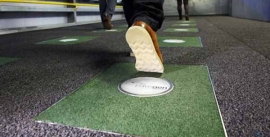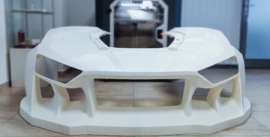 جدید
جدیدافزایش مقاومت در برابر زلزله با یک تک کریستال Improving earthquake resistance with a single crystal
تک کریستال
افزایش مقاومت در برابر زلزله با یک تک کریستال
Improving earthquake resistance with a single crystal
روش حرارتدهی جدیدی برای فلزات معینی میتواند منجر به افزایش مقاومت ساختار مواد در برابر زلزله شود.
——————————————————–
ترجمه از گروه ترجمه ایران مواد
حرفه ای ترین تیم ترجمه مهندسی مواد کشور
———————————————————
محققین و پژوهشگران دانشگاه Tohoko به روشی اقتصادی برای بهبود خواص برخی فلزات حافظهدار که به دلیل تواناییشان در بازگشت به شکل اولیهی خود شناخته میشوند، دست یافتهاند. این روش میتواند راهی را برای تولید انبوه این مواد برای کاربردهای مختلفی مانند مواد با ساختار مقاوم در برابر زلزله، ایجاد کند.
اکثر فلزات از تعداد متعددی بلورهای ریز ساخته شدهاند اما در برخی موارد خواص آنها در صورتی که از یک تک کریستال ساخته شده باشند، بسیار بهبود مییابد. این در حالی است که تولید فلزات تک بلور، گران و پرهزینه میباشد.
محققین روش تولید ارزانتری را بر اساس استفاده از پدیدهای به نام “رشد افراطی دانه” توسعه دادهاند. با استفاده از این روش دانههای یک فلز چندبلور زمانی که در معرض حرارت قرار میگیرد، به طور غیرمعمول و حتی گاهی با مصرف دیگر دانهها، رشد میکند.
فرآیندی که این گروه پژوهشی ابداع کردهاند، شامل چندین سیکل گرمایش و سرمایش میباشد که در نهایت منجر به ایجاد یک میلهی فلزی تک کریستال با طول ۷۰ سانتیمتر و قطر ۱۵ میلیمتر میشود. این ابعاد در مقایسه با میلههای آلیاژهای حفظهدار کنونی بسیار بزرگ میباشد که آن را مناسب برای کاربردهای ساختمانی و مهندسی شهری میسازد.
برای تولید میلهی فلزی تکبلور بزرگ، یک آلیاژ فلزی تا ۹۰۰ درجه سانتی گراد حرارت داده شده و سپس تا ۵۰۰ درجه سانتی گراد سرد شده و این عمل ۵ مرتبه تکرار میشود. در ادامه ۴ مرتبه نمونه را تا ۷۴۰ درجه سانتی گراد حرارت داده و تا ۵۰۰ درجه سانتی گراد سرد میکنند. در نهایت نیز فلز برای آخرین بار تا ۹۰۰ درجه سانتی گراد گرم میشود. بدون انجام سیکلهای ۷۴۰/۵۰۰ درجه سانتی گراد عمل تکبلور شدن رخ نخواهد داد و این مرحله نقش به سزایی در ایجاد میلهی تک کریستال فلزی ایفا میکند.
آلیاژی که در این پژوهش مورد استفاده قرار گرفت، ترکیبی از مس، آلومینیوم و منگنز بوده است که از آلیاژهای حافظهدار شناخته شده میباشدکه ماشینکاری و برشکاری آن ساده میباشد. افزایش اندازهی شدید بلورهای مواد منجر به افزایش الاستیسیته مواد میشود. تغییر شکل آن نیز باعث قویتر شدن ماده میشود. این ترکیب خواص در این مواد برای ساختارهای ساختمانی مقاوم در برابر زلزله بسیار جذاب و مناسب خواهد بود.
به دلیل سادگی فرآیند، این تکنیک برای تولید انبوه تکبلورها دارای مزایای زیادی میباشد. این آلیاژهای تک کریستال و این روش جدید تولید، راهی را برای کاربرد آلیاژهای تک کریستال حافظهدار در مواد ساختاری مانند مواد مورد استفاده در ساختمانها و پلها در نواحی زلزلهخیز، باز میکند. جزئیات این پژوهش در ژورنال Nature Communications به چاپ رسیده است.
منبع: www.sciencedaily.com
مترجم : امیر اشجاری
Improving earthquake resistance with a single crystal
A new heating method for certain metals could lead to improved earthquake-resistant construction materials
Credit: Toshihiro Omori (via Nature Communications)
A new heating method for certain metals could lead to improved earthquake-resistant construction materials.
Tohoku University researchers and colleagues have found an economical way to improve the properties of some ‘shape memory’ metals, known for their ability to return to their original shape after being deformed. The method could make way for the mass production of these improved metals for a variety of applications, including earthquake-resistant construction materials.
Most metals are made of a large number of crystals but, in some cases, their properties improve when they are formed of a single crystal. However, single-crystal metals are expensive to produce.
Researchers have developed a cheaper production method that takes advantage of a phenomenon known as ‘abnormal grain growth.’ By using this method, a metal’s multiple ‘grains’, or crystals, grow irregularly, some at the expense of others, when it is exposed to heat.
The team’s technique involves several cycles of heating and cooling that results in a single-crystal metal bar 70 centimetres in length and 15 millimetres in diameter. This is very large compared to the sizes of current shape memory alloy bars, making it suitable for building and civil engineering applications, says Toshihiro Omori, the lead researcher in the study.
To produce the large single-crystal metal bar, a metal alloy is heated to 900°C then cooled to 500°C, five times. This is followed by four cycles of heating to 740°C then cooling to 500°C. Finally, the metal is heated one last time to 900°C. Omitting the lower temperature heating (740°C)/cooling (500°C) cycles did not lead to the single-crystal result.
The alloy they used, which is made of copper, aluminium and manganese, is a well-known shape memory metal that is easy to cut with machines. Increasing the size of the material’s crystals drastically enhances its elasticity. Altering its shape also makes it quite strong. These combined features make it very attractive for building structures that can withstand earthquakes.
“Since the present technique is advantageous for mass production of single crystals because of the simplicity of the process, this finding opens the way for applications of shape memory single crystals for structural materials, such as for seismic applications in buildings and bridges,” conclude the researchers in their study published in the journal Nature Communications.









دیدگاه کاربران